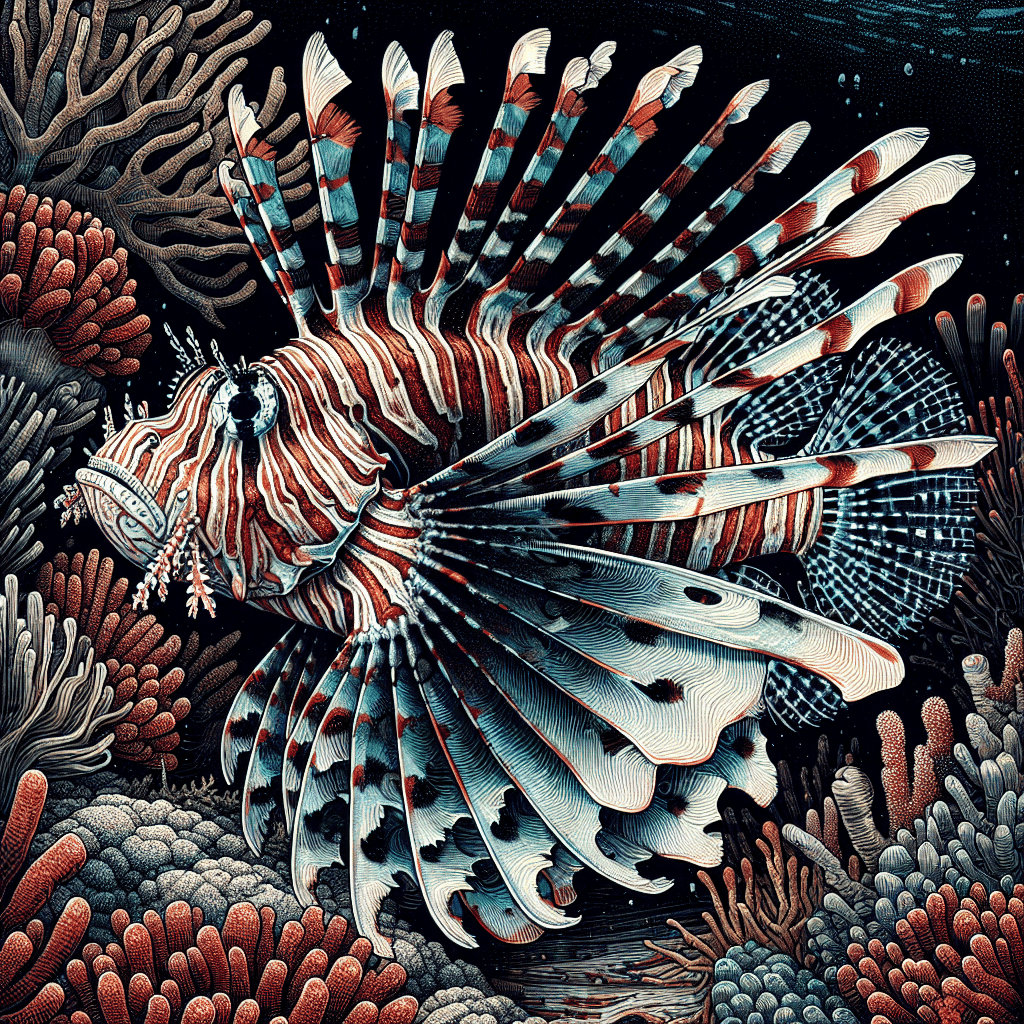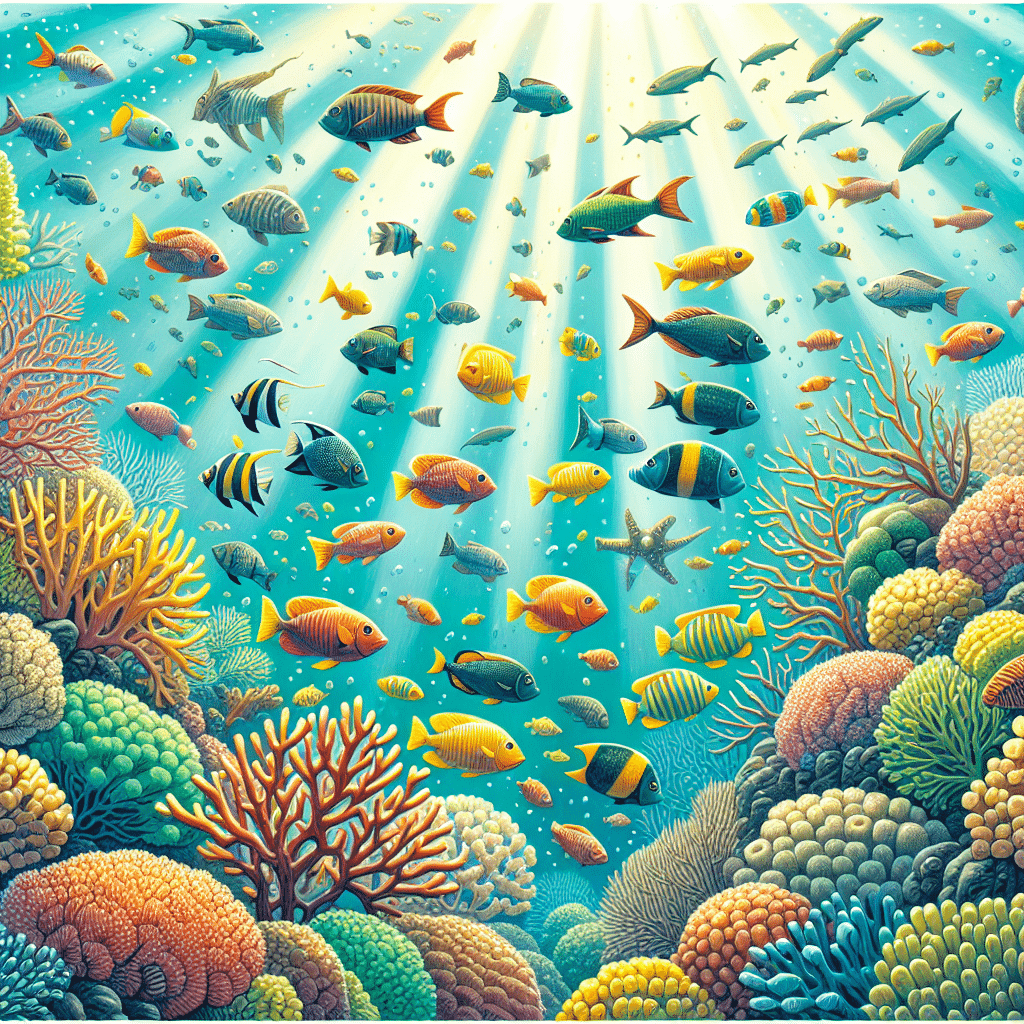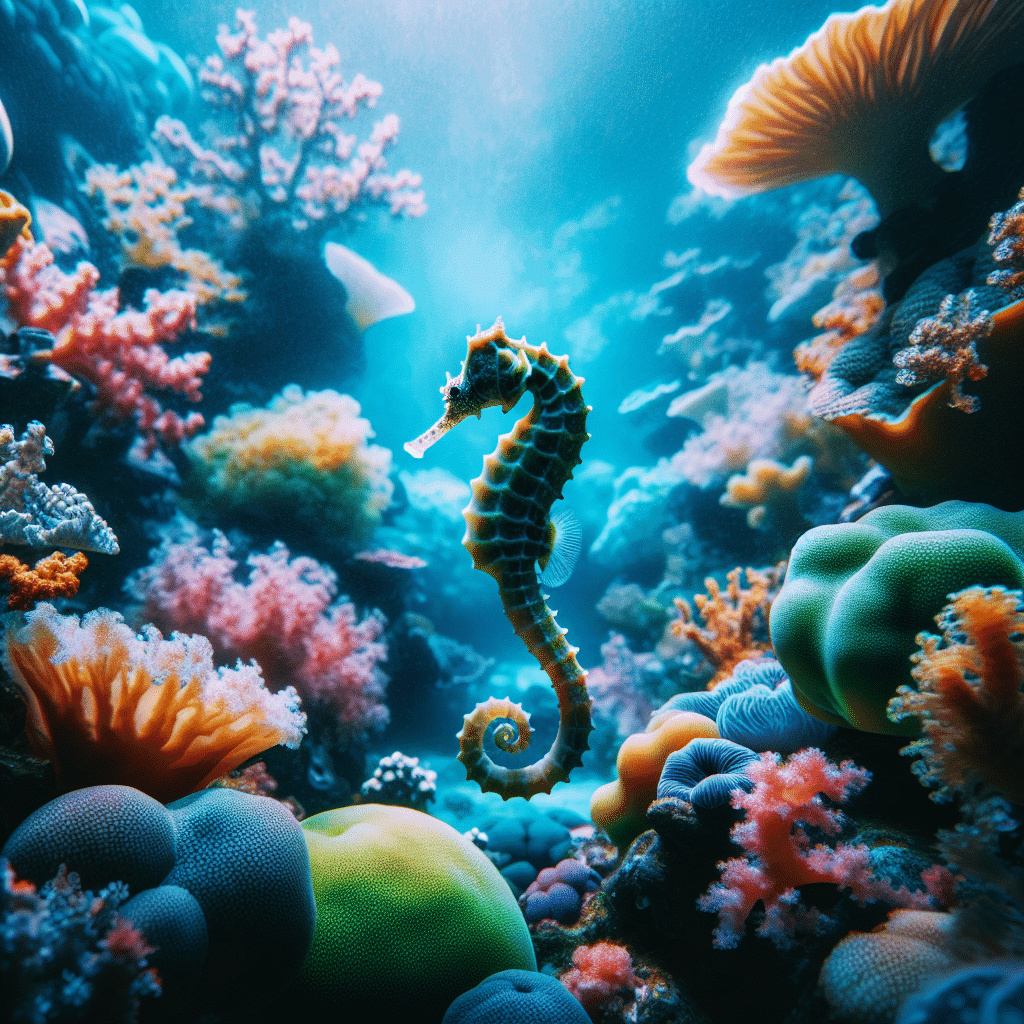Lionfish Overview
Introduction to Lionfish
I’ve always been fascinated by lionfish. These stunning fish are native to the South Pacific Ocean, particularly around Japan, Indonesia, and Australia. However, they’ve become quite the travelers, spreading across the Atlantic from Florida to the Caribbean and even reaching parts of South America. The sight of their vibrant colors and elaborate fins can be mesmerizing, but their presence in non-native waters raises some serious concerns.
Lionfish Habitat and Spread
Lionfish were first spotted off the Florida coast in the mid-1980s. Since then, their populations have exploded, especially in the past 15 years. They’ve made homes in various regions of the Atlantic, which includes not only Florida but also Bermuda, the Bahamas, and further into the Caribbean. Two species, Pterois volitans and P. miles, are commonly found in these areas.
Here’s a quick table summarizing some key locations where lionfish are found:
| Region | First Detected | Current Spread |
|---|---|---|
| Florida | Mid-1980s | Extensive along the coast |
| Caribbean | 1990s | Widespread across multiple islands |
| South America | Early 2000s | Present in select coastal areas |
The rapid expansion of lionfish populations is alarming to scientists and conservationists. They have become established in many marine ecosystems, where they compete with native species for food and resources. If you’re interested in other marine fish that share these waters, you might want to check out grouper or snapper species.
Understanding the habitat and spread of lionfish is essential for anyone involved in reef tank hobbies, as their presence has significant implications for the health of marine ecosystems.
Lionfish Diet
Prey Species of Lionfish
As a lionfish owner or enthusiast, I find it fascinating to learn about their diverse diet. Lionfish are voracious predators that consume a wide variety of prey, which can impact local fish populations significantly. They traditionally ate crabs, shrimp, and other fish but have adapted to consume over 50 species of fish in their new environments. According to studies, a lionfish can eat about 60,000 reef fish by the time it turns two years old (Lionfish Divers).
Here’s a breakdown of some of the prey species commonly targeted by lionfish:
| Prey Species | Percentage of Diet |
|---|---|
| Grunts | 41% |
| Parrotfish | Varies |
| Filefish | Varies |
| Lizardfish | Varies |
| Cardinalfish | Varies |
| Blenny | Varies |
| Grouper | Varies |
| Other Fish Families | >50 species total |
Interestingly, lionfish tend to avoid the Sparidae family, which includes pinfish and porgies, and instead prefer other native fish families more frequently than expected.
Impact on Marine Ecosystems
The impact of lionfish on marine ecosystems is quite dramatic. Their insatiable appetite and lack of natural predators allow them to proliferate rapidly, leading to overpopulation in certain areas. This can have dire consequences for local fish populations, particularly for species like grunts and groupers that make up a large portion of their diet.
Lionfish can wipe out up to 90% of a reef’s fish population, which not only disrupts the balance of the ecosystem but also affects fishermen targeting these species on North Carolina reefs (NC Sea Grant). With the ability to spawn tens of thousands of eggs every few days, the lionfish’s reproductive capabilities further exacerbate their impact, often leading to obesity and liver damage due to overfeeding (Fishing Booker).
For hobbyists like me, understanding the dietary habits of lionfish is crucial, especially if I plan to maintain a balanced reef tank. It’s important to consider how lionfish interact with other marine life, including species like grouper, snapper, and clownfish, to ensure a healthy environment for all my aquarium inhabitants.
Lionfish Reproduction
Reproduction in lionfish is quite fascinating, especially for those of us who appreciate the dynamics of marine life in our reef tanks. Understanding their reproductive characteristics can help hobbyists manage their populations better.
Reproductive Characteristics
Female lionfish are prolific breeders. They can produce around 30,000 eggs every four days, which contributes significantly to their rapid population growth in the Atlantic. In the Caribbean, these fish breed year-round, with each female capable of producing two egg sacs every four days, each containing approximately 15,000 eggs. In total, that can amount to about 2,000,000 eggs per female each year (YPTE, Lionfish-Hunting).
Here’s a quick overview of their reproductive capabilities:
| Reproductive Feature | Details |
|---|---|
| Egg Production per Cycle | 15,000 eggs |
| Frequency of Egg Laying | Every 3 to 4 days |
| Total Eggs per Year | Approximately 2,000,000 eggs |
| Time to Maturity | About 1 year |
Egg Production and Hatching
The spawning of lionfish is a sight to behold. After fertilization, the eggs float in the water column, where they remain for about 25 to 30 days before hatching. During this larval duration, the larvae are capable swimmers and can start feeding on small ciliates and other zooplankton just four days post-fertilization (Lionfish-Hunting).
After about three months, these larvae begin to resemble mini versions of their adult counterparts. This rapid growth and high reproductive rate are key factors in their ability to thrive in non-native waters, making them a significant concern for marine ecosystems.
If you’re interested in learning more about the diverse marine life that shares their habitat, check out our articles on marine fish, barracuda, and seahorse. Understanding the dynamics of these species can help us create a healthier environment for our reef tanks.
Lionfish Threats
Population Growth and Impact
The lionfish population has exploded in the Atlantic and Caribbean over the past two decades, raising alarms among scientists and conservationists. It all started when lionfish were first spotted along the Florida coasts in the mid-1980s. Since then, their numbers have surged dramatically, leading to significant ecological concerns (NOAA Fisheries). This rapid growth not only threatens the biodiversity of coral reefs but also disrupts the balance within established marine ecosystems.
One of the most concerning aspects of this population boom is the lionfish’s diet, which predominantly consists of native fish species such as grunts, sea basses, and groupers. In fact, grunts make up a staggering 41% of their diet (NC Sea Grant). This predation poses a serious threat to these fish populations, which can have a cascading effect on the fishing industry and local economies that rely on these species.
| Species Targeted by Lionfish | Percentage of Diet |
|---|---|
| Grunts | 41% |
| Sea Basses | Varies |
| Groupers | Varies |
Effects on Native Fish Species
The impact of lionfish on native fish species is profound. As they continue to flourish in their non-native habitats, they compete for resources with local marine life. This competition can lead to declines in native fish populations, which in turn affects the entire ecosystem, including species that have a symbiotic relationship with others, such as clownfish and grouper.
Additionally, the invasive nature of lionfish disrupts the feeding and breeding patterns of native species, leading to an imbalance in the ecosystem. The growing lionfish population demands more prey, further stressing the already vulnerable marine communities. This situation could have serious consequences for the fishing and tourism industries, which are crucial for many coastal regions.
Efforts to combat the lionfish invasion include organized hunting and catching sessions, as these fish are not only invasive but also considered delicious and edible. As fish tank and reef tank hobbyists, it’s essential to stay informed about these threats and the ongoing efforts to manage lionfish populations for the health of marine ecosystems.
Lionfish Control Efforts
Hunting and Catching Initiatives
One effective way to manage lionfish populations is through organized hunting and catching initiatives. Many countries and islands have recognized lionfish as both a culinary delight and an ecological threat, leading to efforts to encourage their consumption. These initiatives often involve community events where participants can hunt lionfish, which helps reduce their numbers while also promoting awareness about their impact on local ecosystems.
Communities have started hosting lionfish derbies, where fishermen compete to catch the most lionfish. These events not only help deplete the population but also educate participants and spectators about the importance of controlling this invasive species. Plus, lionfish are considered delicious and can be a great addition to any seafood dish.
| Initiative Type | Description |
|---|---|
| Community Derbies | Fishing competitions to catch lionfish. |
| Public Awareness Events | Informative sessions on lionfish impact and cooking demonstrations. |
| Culinary Promotions | Encouraging restaurants to serve lionfish dishes. |
Strategies for Population Management
Various organizations and conservation groups have implemented strategies to manage lionfish populations effectively. These efforts include public awareness campaigns and systematic removal initiatives. One notable resource is the NOAA’s Invasive Lionfish Web Portal, which provides information and tools for outreach, education, and research related to lionfish management.
Additionally, the Aquatic Nuisance Species Task Force has developed a National Invasive Lionfish Prevention and Management Plan, guiding local and federal efforts in managing lionfish in vulnerable areas.
Key strategies for managing lionfish populations include:
- Encouraging Consumption: Promoting lionfish as a sustainable seafood choice.
- Organized Removals: Collaborative efforts to systematically remove lionfish from affected areas.
- Reporting Sightings: Encouraging divers and fishermen to report lionfish sightings to help track their spread.
While complete eradication of lionfish is unlikely, these combined efforts can help control their population and mitigate their impact on marine ecosystems. For those of us involved in reef tank hobbies, understanding these management strategies can enhance our knowledge of how to care for the delicate balance of marine life in our tanks.
Lionfish Invasiveness
Spread and Range Expansion
I’ve been fascinated by the rapid expansion of lionfish populations across the Atlantic and Caribbean over the past couple of decades. It all started when lionfish were first identified in South Florida waters in 1985. Since then, these beautiful but invasive fish have made their way up the Atlantic Coast as far north as Long Island and have established themselves around reefs in the Gulf of Mexico and the Caribbean.
The numbers are staggering, with densities reaching up to 500 lionfish per hectare in some areas. This explosive growth is a cause for concern among scientists and conservationists, as it poses a significant threat to local ecosystems (NOAA).
| Year | Location | Notable Expansion |
|---|---|---|
| 1985 | South Florida | First identification |
| 1990s | Caribbean | Spread throughout the region |
| 2000s | Gulf of Mexico | Established populations |
| Present | Long Island | Reached as far north as Long Island |
Impact on Reef Communities
The impact of lionfish on reef communities is quite profound. Their presence threatens biodiversity and the resilience of these delicate ecosystems. As they feast on native reef fish and marine invertebrates, lionfish are reducing the populations of species that are crucial for maintaining healthy reefs (NOAA).
This not only affects the food web but can also hamper the recovery of economically and ecologically important species. For reef tank hobbyists like me, it’s vital to understand how lionfish disrupt the balance of marine life.
In addition to the ecological impacts, the presence of lionfish changes the dynamics of reef communities. They are generalist feeders, meaning they’ll consume a wide variety of prey, making them even more challenging to control.
For anyone interested in marine life, the lionfish situation serves as a reminder of the importance of maintaining healthy ecosystems. To learn more about the fascinating species that share these reefs, check out our articles on marine fish, clownfish, and parrotfish.
Conservation Measures
Mitigating Lionfish Impact
As a reef tank enthusiast, I know how important it is to keep our marine ecosystems healthy. Lionfish have become a significant threat to these environments, and several measures are being implemented to mitigate their impact. Many countries and islands are organizing hunting and catching sessions, encouraging people to fish for these invasive predators. The good news is that lionfish are not only edible but also considered quite delicious (YPTE).
Organizations and conservationists are promoting public awareness campaigns to inform hobbyists and the general public about the issues lionfish cause. They’re also encouraging the consumption of lionfish and organizing removal initiatives to help control their population.
| Method | Description |
|---|---|
| Public Awareness Campaigns | Informing communities about the lionfish problem and its impact on ecosystems. |
| Fishing Initiatives | Encouraging the fishing of lionfish for consumption. |
| Organized Removal | Coordinating events to catch lionfish in affected areas. |
Collaborative Management Approaches
Effective management of lionfish requires collaboration among various stakeholders. NOAA has developed an Invasive Lionfish Web Portal that serves as a valuable resource for outreach, education, research, monitoring, and management related to lionfish. This portal emphasizes the need for cooperation among local, state, federal, and international partners to tackle the lionfish issue effectively.
Additionally, the Aquatic Nuisance Species Task Force has established a National Invasive Lionfish Prevention and Management Plan. NOAA’s National Marine Sanctuaries Program also has a specific lionfish plan to guide management efforts in affected sanctuaries in the Gulf and southeastern United States (NOAA Fisheries).
Scientists effectively agree that while complete eradication of lionfish is unlikely, effective population control methods are achievable. Recommendations include eating them, participating in lionfish derbies, and reporting sightings to help manage their spread (Fishing Booker).
By staying informed and actively participating in these conservation efforts, I can contribute to maintaining the health of our reef ecosystems while enjoying the beauty of our marine companions.
Lionfish Research Findings
Dietary Preferences
As a fish tank enthusiast, understanding the dietary habits of lionfish is essential for their care and feeding. Lionfish are generalist carnivores, meaning they have a diverse diet that adapts as they grow. Research indicates that lionfish collected off the coast of North Carolina had 81% of their stomachs containing food, with 96% having consumed prey fish from 19 different groups (University of Miami).
Interestingly, lionfish tend to avoid the Sparidae family, which includes pinfish and porgies. Instead, they more frequently consume other native fish families, such as parrotfish, filefish, lizardfish, cardinalfish, blennies, and groupers. Grunts make up a significant portion of their diet, accounting for 41% of what they eat.
Here’s a quick overview of lionfish dietary preferences:
| Prey Type | Frequency in Diet (%) |
|---|---|
| Grunts | 41 |
| Parrotfish | Varies |
| Filefish | Varies |
| Lizardfish | Varies |
| Cardinalfish | Varies |
| Blennies | Varies |
| Groupers | Varies |
Lionfish traditionally ate crabs, shrimp, and other fish, but they now consume over 50 species of fish in their new environments. On average, a lionfish will eat about 60,000 reef fish by the time it turns two.
Ecological Role in Marine Ecosystems
The impact of lionfish on marine ecosystems is significant. As they grow, their diet shifts to larger prey, which can lead to a decline in local fish populations. Stable isotope analysis of lionfish tissues reveals that 77% of the carbon-13 in their diet comes from microalgae and other primary producers, indicating they also feed on phytoplankton and bottom-dwelling algae. This characteristic reflects their role at various levels of the food chain.
In addition to their direct impact on fish populations, lionfish also threaten species that fishermen target, such as grunts and groupers. Their predation can disrupt local fishing industries and alter the balance of reef communities. As a hobbyist, understanding this ecological role can help in making informed decisions about keeping these fish in your aquarium and recognizing the broader implications for reef health.
For more information on marine fish care, check out our articles on marine fish and specific species like grouper or clownfish to enhance your knowledge about maintaining a thriving reef tank.



